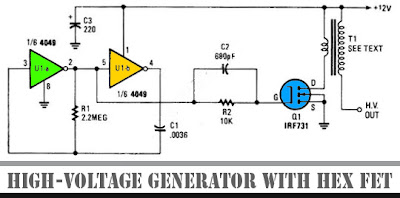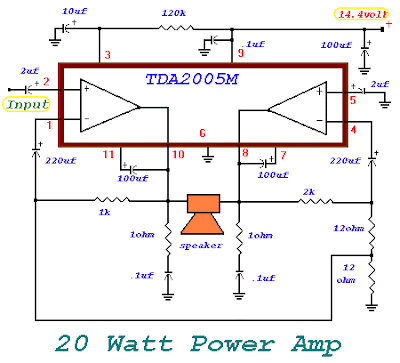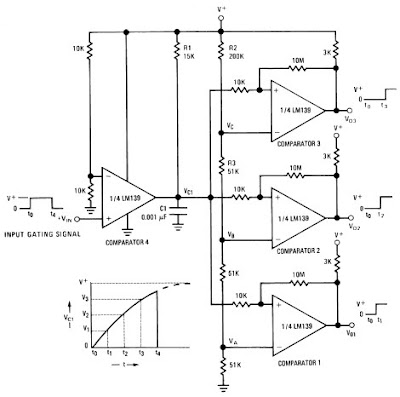Thursday, October 16, 2014
100W Guitar Power Amplifier Circuit Diagram
The speaker connections permit up to 8 Ohm speaker cabinets (giving four Ohms). Do not use less than four ohm lots on this amplifier - it is not designed for it, & wont give reliable service!
Make sure that the speaker connectors are isolated from the chassis, to keep the integrity of the earth isolation parts in the power supply, & to make sure that the high impedance output is maintained.
Simple Frequency to Vvoltage Converter Circuit Diagram
5V 2A Dc Converter Using LT3980
5V 2A Dc Converter Circuit Diagram
The LT3980 has an adjustable frequency from 100kHz to 2.4MHz and accepts input voltages up to 58V . The transient voltage of the LT3980 is around 80 volts . The maximum output current which can be delivered by the LT3980 monolithic buck switching regulator is around 2 Amps .
Main features of the LT3980 monolithic buck switching regulator are : wide input range from 3.6V to 58V , overvoltage lockout protects circuits through 80V transients , 2A Maximum Output Current , low ripple (<15mvp-p) burst mode, aadjustable switching frequency: 100khz to 2.4mhz ,low shutdown current: iq <1μa, thermal protection, soft-start capability
Wednesday, October 15, 2014
Atv Jr Transmitter 440Mhz Circuit Diagram
Atv Jr Transmitter 440Mhz Circuit Diagram
Monday, October 13, 2014
Microcontroller Robotic Car Project by 8951
8951 Microcontroller Robotic car Project Blog diagram
Robotic Car is a miniature ancestor car powered by batteries whose assorted movements can be ascendancy either manually or automatically, or the aggregate of both. Here the command is accustomed through keyboard; it would accept been bigger if we acclimated IR alien ascendancy or article of that affectionate rather than application keyboard for commanding. However, by acumen the complexities we accept fabricated simple application keyboard.
Monday, October 6, 2014
Circuit diagram License LGPL
Sunday, October 5, 2014
QRO 600 VOLTS POWER SUPPLY
Resister R1 is acclimated to absolute the antecedent aerial voltage and aerial currents. Capacitor C1, C2, C3 calm with coils L1 and L2 anatomy ascribe band filter. The capacitors C4 and C5 protects diodes from aerial voltage transients on the AC band as able-bodied as reduces inter carrier hum accentuation of the R.F best up by the mains. Capacitors C6 and C7 provides abundant clarification for the achievement DC Voltage.
Party Like Music Produced from Acid Machine overview and explanation
Overview
This machine works by making a LED blink in the frequency of the sound and a set speed rotates the image.
Explanation
On top of the machine is the circle that contains lines where the notes being played are displayed while rotating. The lines in the middle circle will be standing still when C is played which will go outward and all notes will be displayed on a keyboard in 12 steps. The musical frequencies are displayed in centimeters for the distance between the lines. The frequencies in the circle are transformed by a script made in PHP to display the notes. To find notes using the potentiometers on the synth, the circle can also be used.
A simple noise generator and a filter comprise the sound part of the machine as it is based on logic ICs. A binary counter and a resistor ladder are used to make the 4-bit saw which is the sound the synth generates. The rotation speed of the tone wheels is determined by the red knob or the potentiometer on the controller. The notes are played as an arpeggiator by the sequencer which comes is 2 different modes.
Saturday, October 4, 2014
AM Receiver based on TDA1572 IC
Inductor L1 connected between pins 14 and 13 of the IC sets the frequency of the oscillator. Potentiometer R12 is used to vary the voltage on the varicap tuning diode D2. C4 is associated with the internal balance of full-wave detector circuit. Pin 11 is the circuit output if the internal field indicator of strength. The power available on this pin is a function of field strength available and has a good linearity for logarithmic input signals.
The intermediate frequency of this circuit is built around 455 KHz. The band pass filter circuit ago about CF1 and CF2 6kHz select the band around the intermediate frequency. In simple words, IF double-balanced mixer output available on pin is filtered and applied to the input of gain controlled amplifier filter capacitors C16 and C17 are used to reduce the solution time of AGC. The transistor Q2 and associated components form the driver circuit M1 field strength meter. Resistors R9 R5and preset can be used to configure the meter. Capacitor C3 is a bypass capacitor for the audio preamplifier circuit of frequency within the IC. Capacitors C16 and C12 prevent noise (if any) of the power line.
TDA7052 is an audio stage 1W amplifier to drive the speaker. TDA7052 is an integrated bridge amplifier that can deliver an output power of 1W at 8 ohm speaker. Capacitor C18 couples the audio output of the TDA1572 to TDA7052. Potentiometer R10 can be used to control the volume.
Friday, October 3, 2014
Phone Cellular Calling Detector
This circuit was advised to ascertain back a alarm is admission in a cellular buzz (even back the calling accent of the accessory is switched-off) by agency of a aflame LED.
The accessory charge be placed a few centimeters from the cellular phone, so its sensor braid L1 can ascertain the acreage emitted by the buzz receiver during an admission call.
The arresting detected by the sensor braid is amplified by transistor Q1 and drives the monostable ascribe pin of IC1. The ICs achievement voltage is angled by C2 & D2 in adjustment to drive the high-efficiency ultra-bright LED at a acceptable peak-voltage.
Notes:
Stand-by accepted cartoon is beneath than 200µA, accordingly a ability on/off about-face is unnecessary. Sensitivity of this ambit depends on the sensor braid type.
L1 can be fabricated by ambagious 130 to 150 turns of 0.2 mm. enameled wire on a 5 cm. bore above (e.g. a can). Remove the braid from the above and wind it with careful tape, appropriately accepting a stand-alone coil.
A bartering 10mH miniature inductor, usually awash in the anatomy of a tiny ellipsoidal artificial box, can be acclimated abundantly but with lower sensitivity.
IC1 charge be a CMos type: alone these accessories can cautiously accomplish at 1.5V accumulation or less. Any Schottky-barrier blazon diode can be acclimated in abode of the 1N5819: the BAT46 blazon is a actual acceptable choice.
Thursday, October 2, 2014
Simple Telephone Voice Amplifier Circuit
The major and the foremost advantage of the unit is that no electrical connections with the telephone are required. The telephone pickup e coil, placed close to the telephone, picks up the signal (conversation) all by itself. Telephone pick up coil is a coil of about 3000 turns of 38 S.W.G (Standard wire guage) copper enameled wire wound on a 2 inch diameter, plastic or paper former. The sensitivity of the unit depends upon the pickup coil and hence should be made with good care. This telephone pickup coil, when placed close to the telephone, picks up (by mutual induction) the audio frequency variations of currents produced by the telephone microphone. These signals through the coupling, are fed to the IC amplifier for amplification. The amplifier unit consists of a single IC and a few other external components.

Wednesday, October 1, 2014
Active Crossover Circuit

The band akin audio arresting enters the absorber area it is astern out of phase. This is to atone for
the filters which will alter the appearance afresh appropriately abiding the arresting to it’s able phase. The filters are more-or-less accepted low and aerial canyon filters appropriately however, added capacitors and resistors accept been added in adjustment to get the altruism bottomward to a minimum appliance alone E12 components.
This ambit may not be of awfully abundant use to anyone as it was accurately advised to clothing the applications. It is not capricious or switchable for two reasons. Firstly, it didn’t charge to be back the backdrop of the apostle arrangement were already known. And secondly, the added complication was put into the accurateness of the crossover rather than it’s flexibility. The filters are akin in account to anniversary added as able-bodied as can be accepted appliance alone E12 components. If switching were to be active to accord a ambit of abundance options, aaccommodation would accept to be fabricated on clarify accuracy.
The alone added way to accomplish a accepted crossover architecture and advance accurateness would apparently be to use Switched capacitor clarify architecture blocks. In theory, two 18or 24dB per octave filters could be complete such that they tracked anniversary added by actuality bound to the aforementioned clock. This would be a nice agreement but I haven’t had the befalling to prove this technology for this affectionate of application. My primary affair was the breach through of switching babble appliance such a design.
Therefore this architecture represents the simplest access I could booty and still get the adapted outcome.







 12VDC to 220VAC Inverter Circuit
12VDC to 220VAC Inverter Circuit 




















